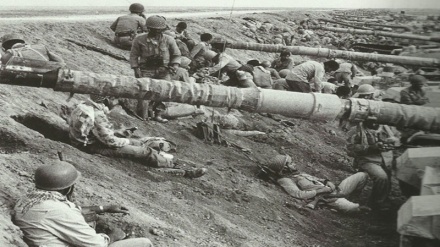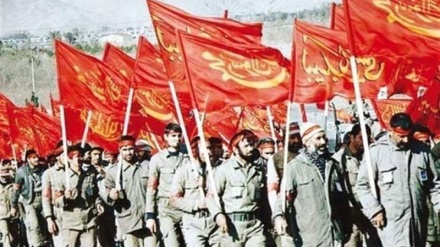Glimpses of Epic of the 8-Year Holy Defense (77)
In the previous program we talked about the political and field developments of 1986, following the successful operation of Val-Fajr 8 operation in Faw Peninsula and Karbala 1 operation and the liberation of Mehran.
Saddam's Ba'athist regime, with the financial, military, political and intelligence support of the two Western and Eastern powers and their satellites, targeted oil tankers, economic and military centers of Iran, and cities and villages to undermine the Islamic Republic's infrastructures and also morale of the people and the military forces.
As the war on oil tankers and targeting oil export terminals and docks continued, Iran's oil export decreased and in view of increase of Saudi oil production, the oil price dropped to seven dollars per barrel. The prolongation of the war could have a direct effect on Iran's superiority over Iraq which was gained after the second year of the war. For this reason, the Iranian military and political officials designated 1986 as the year of the war's fate. On June 5, 1986, Majles speaker, Hashemi Rafsanjani, stated in a gathering of commanders and officials of the IRGC, "In the calculations that have been made so far, we think there is no better way but to accelerate the war. The most reasonable way is not to waste time. Time is not in our favor to stay idly. The general state and economic conditions of the country urge us to reach this point sooner." Accordingly, the IRGC prepared a plan to carry out operations throughout the southern front and accomplish the issue of southern Iraq and Basra. The plan was to operate 500 battalions on each axis. But some officials believed it was impossible to mobilize and organize this amount of power and equipment.
Eventually, an operation was planned to mobilize 500 battalions. The IRGC regularly raised the issue that the fateful attack should not be considered a final attack. Iran was hopeful to bring the war to a point where it would frustrate and browbeat Saddam and its criminal supporters, forcing them to surrender to the rightful demands of the Islamic Republic. Hashmi Rafsanjani commented, "Despite various interpretations, this does not mean that the war will end this year, but with our plans we want to bring the war to a point where Iran's victory is guaranteed."
To plan and launch fateful operations would require presence of more volunteer forces as the existing number of forces on the battle theaters was not adequate. Meanwhile, the victories of the Iranian combatants on the battlefields, as well as the difficulties that the US and Britain faced regarding their nationals in Lebanon, had made the circumstances volatile. What could solve the problem were successful operations on the warfront, in addition to the necessity of active foreign policy.
It was possible to plan and launch any operation with the participation of Basij volunteer forces. The IRGC launched a new initiative and put on the agenda to mobilize 100,000-strong corps of Prophet Mohammad on the anniversary of the founding of the Basij on November 26th. To encourage the youths to join Basij to be dispatched to the battlefronts, the 21,000 Basij bases across the country were mandated to provide such a force through contact and communication with the people.
300 battalions were eventually deployed to carry out the decisive operations. The IRGC units identified a few geostrategic points, including Majnoon Islands and Shalamcheh area to assess the possibility of an attack from those areas against the Ba'athist forces. During the reconnaissance operations and taking into account the political-military dimensions, the general area of operation was eventually selected as a pentagonal area north of Shalamcheh stretching 4 kilometers south of Minoo island with two axes of Shalamcheh and Abu al-Khaseeb, targeting Basra. From a military point of view, Karbala 4 operational area was considered the last war effort in the south, as the area was selected for operations due to the strategic and military value as well as its compliance with the Islamic Republic's military might.
Karbala 4 operation was designed to seize the Abu al-Khaseeb area and to besiege troops stationed in the Faw Peninsula and threaten Basra from the south. The operation sought to link the Val-Fajr 8 operational area that is Faw Peninsula and seize the entire Arvand River. The operation was in line with the objectives of Val-Fajr 8 operation and was intended to liberate the entire area of Faw Island and further strengthen Iran's position in the Persian Gulf. Karbala 4 operation helped expand the area around the bridge captured in the Faw area and it was saved from the risk of being recaptured by the Ba'athist army.
Based on previous records of these operational areas, a special tactic was employed for the operation. In fact, the special tactic was considered as the key to the success of the operation and the main element to make the enemy perplexed as from which side the attack was being launched. The Iraqi Ba'athist army was actually desperate to defend meaning that it would have difficulty in identifying and understanding the main objective. The attack was on the one hand targeted towards Abu al-Khaseeb and Basra, and on the other it could have been aimed at blocking the Iraqi seventh division. In this plan, palm trees around Arvand River were considered the heart of the region. The scheming of the fateful operation was based on a special tactic and the hope to surprise the enemy. During the public mobilization, which began in mid-1986, most of the country's amenities had put at the service of the war. The public atmosphere and the general mobilization of forces and facilities were indicative of an attempt to end the war with the "fateful operation" of Karbala 4. But things did not go as Iranian commanders and combatants had predicted. Next time we will elaborate the issue.
FK/ME


